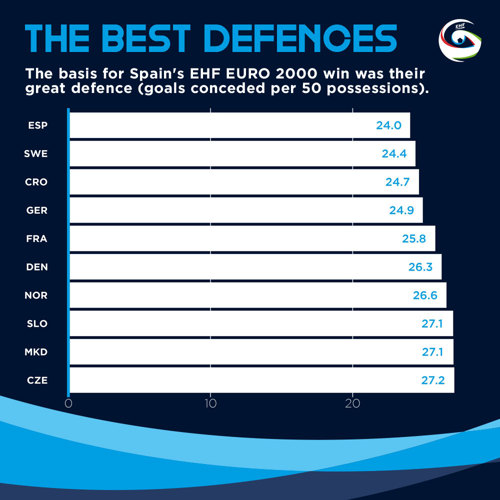In just a few days, the Men's EHF EURO 2022 will begin – so it is time to look at past data from Kinexon for the top teams and what that says about the upcoming European Championship.
Spain and Croatia: the finalists of the last EURO
Two years ago, at the final of the EHF EURO 2020, Spain defeated Croatia 22:20 to win their second European Championship in a row. They were able to remain undefeated throughout the tournament because they were great on both sides of the field.
While the Croatians were praised for their great defence, in fact Jordi Ribera’s team were even better on that side of the court, despite conceding 2.3 goals per game more than the Croatians.
The big difference between the two finalists was that Spain’s games were much faster-paced than Croatia’s. In fact, Lino Cervar’s team had the least possessions per game of all teams at the tournament with just 46.4. Spain had 5.8 more – no wonder they conceded more goals. And just playing faster or slower is of course not necessarily a feature of a good or bad defence.
So, it is much fairer to create an equal basis for everyone. Since the average number of possessions is around 50 (50.3 at EHF EURO 2020) comparing statistics normalised to 50 possessions allows a fair comparison between teams. Applying this, Spain’s defence was the best of the tournament in 2020 with just 24.0 goals conceded per 50 possessions – slightly better than Croatia (24.7).

The reasons for these good numbers are that both teams were especially great at forcing technical faults (Spain first with 12.7 per 50 possessions, Croatia second with 12.6 per 50 possessions). Of course, this is also a consequence of the 5-1 defence on which both teams relied. In attack, Spain was great as well. With 29.6 goals per 50 possessions, they had the second-best attack of the tournament.
In contrast, Croatia had some problems in attack. Their shooting percentage (59.3 per cent) and number of technical faults (10.2 per 50 possessions) were around average which resulted in marginally above-average 27.2 goals per 50 possessions. Nevertheless, Spain were the only team they could not defeat.
Even though Spain won in 2020 with the oldest team of the tournament at an average age of 31, the turnover in their team has not been too big. The players that played 69.1 per cent of the minutes then are expected to play at the EHF EURO 2022 as well. They may not be as outstanding as they were two years ago, but they are still clearly among the favourites.
For Croatia the situation is different. Hrvoje Horvat has replaced Lino Cervar as coach and this year’s squad includes players who together played just 35.4 per cent of the minutes two years ago. Therefore, any forecast of quality or playing style based on data is difficult, but it seems that they are not on the same level.







